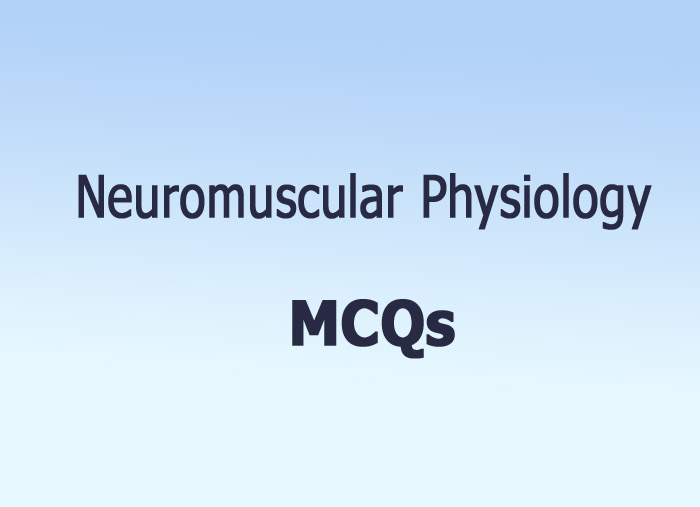- NEED HELP? CALL US NOW
- +919995411505
- [email protected]

1. The ends of the actin filaments are anchored (attached) to the:
a) M-line
b) Z-line
c) Perimysium
d) Sarcoplasmic reticulum
answer: B
The ends of the actin filaments are anchored to the Z-line or disk, whereas the M-line is in the centre of each sarcomere. The perimysium envelops a bundle of muscle fibres. The sarcoplasmic reticulum surrounds each myofibril.
2. When a muscle fibre shortens, the following also shortens:
a) Sarcomere
b) Actin filament
c) Myosin filament
d) Z-line
answer: A
The sarcomere shortens but myosin and actin filaments do not. The thickness of the Z-line remains unchanged.
3. In regard to the cross-bridge (CB) power stroke, it is true that:
a) In concentric contractions, the CB power stroke pulls the actin filament toward the center of the sarcomere, causing sarcomere shortening.
b) In eccentric contractions, the CB power stroke pushes the actin filament away from the centre of the sarcomere, causing sarcomere lengthening.
c) In isometric contractions, the CB power stroke pulls the actin filament straight down, preventing shortening or lengthening.
d) All of the above are true.
Answer: A
CB power strokes always act to cause sarcomere shortening. Whether shortening, lengthening or no change in sarcomere length occurs depends on the load on the sarcomere (muscle).
4. During one cross-bridge (CB) cycle:
a) The CB binds to troponin.
b) ATP binds to the actin binding site.
c) One molecule of ATP is used.
d) The CB performs two power-strokes.
Answer: A
In each CB cycle, the CB binds to an actin binding site, one power stroke is performed and one molecule of ATP is used.
5. In excitation-contraction coupling:
a) The muscle action potential propagates along the sarcolemma and down the transverse tubules.
b) Ca2+ released from the sarcoplasmic reticulum binds to tropomyosin.
c) Troponin blocks binding of myosin heads to actin filaments.
d) Relaxation occurs when Ca2+ is excreted from the muscle fibre.
Answer: A
The muscle action potential causes the sarcoplasmic reticulum to release Ca2+, which binds to troponin, which causes tropomyosin to be pulled aside, allowing cross-bridges (CBs) to bind to actin to initiate CB cycling. Relaxation occurs when Ca2+ is taken back up into the sarcoplasmic reticulum.
6. The sarcoplasmic reticulum does not:
a) Surround each myofibril.
b) Release Ca2+ in response to a muscle action potential.
c) Has a Ca2+ “pump” in its membrane.
d) Make up about 85% of the contents of a muscle fibre.
Answer: D
The sarcoplasmic reticulum (SR) makes up only about a few percent of the contents of a muscle fibre. The SR does surround each myofibril, release Ca2+ in response to a muscle action potential and has a Ca2+ “pump” in its membrane.
7. At the neuromuscular junction
a) the muscle membrane possesses muscarinic receptors
b) there is a one-to-one transmission of excitatory impulses from the motor neurone to the muscle fibres it innervates
c) the motor nerve endings secrete noradrenaline
d) the typical summed end plate potential (EPP) is usually 10 times the potential necessary to trigger an action potential
answer: B
8. Eccentric contractions are stronger than isometric and concentric contractions partly because, in eccentric contractions:
a) More muscle fibres within a muscle are activated.
b) Within each muscle fibre, more cross-bridges are attached to actin at a given time.
c) Muscle fibres are conducting muscle action potentials at a higher frequency.
d) More ATP is used in each cross-bridge cycle.
Answer: B
Assuming maximal activation, in eccentric contractions more cross-bridges are attached to actin in each muscle fibre at a given time, producing more force. This does not require more ATP.
9. The force of a tetanic contraction is greater than that of a twitch contraction because:
a) More acetylcholine is released at the neuromuscular junction per nerve impulse.
b) More Ca2+ is released in a tetanic contraction.
c) The muscle action potentials travel faster along the transverse tubules.
d) The muscle action potentials are smaller during a tetanic contraction.
Answer: B
Compared to a twitch, the greater force of a tetanus is due to greater Ca2+ release and greater take-up of the series elastic component. The greater force is not related to the size or speed of muscle action potentials.
10.An action potential in the motor end plate rapidly spreads to the central portions of the muscle cells by means of the
a) Z-lines
b) sarcoplasmic reticulum
c) pore in the plasma membrane
d) transverse tubules
answer: D




